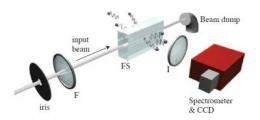Simulating black hole radiation with lasers

Hawking radiation from black holes is very dim, and unlikely to be detected any time soon. Now researchers have created a laboratory experiment that produces detectable Hawking radiation with a laser.
A team of Italian scientists has fired a laser beam into a hunk of glass to create what they believe is an optical analogue of the Hawking radiation that many physicists expect is emitted by black holes. Although the laser experiment superficially bears little resemblance to ultra-dense black holes, the mathematical theories used to describe both are similar enough that confirmation of laser-induced Hawking radiation would bolster confidence that black holes also emit Hawking radiation.
When Stephen Hawking first predicted the radiation bearing his name in 1974, he hypothesized that photons could be spontaneously generated from the vacuum at the edge of a black hole. However, Hawking radiation emitted from a black hole would be so weak that many scientists believe it to be nearly impossible to detect.
Scientists have turned to lasers before in attempts to create Hawking radiation, but have had difficulty isolating Hawking radiation from other forms of light emitted during experiments. Franco Belgiorno et al. combined a tunable laser beam with a bulk glass target, which allowed them to limit the Hawking radiation to certain wavelengths of infrared light and to capture the apparent Hawking radiation with an infrared sensitive digital camera.
A paper describing the possible production of a laser induced analogue of Hawking radiation appears in the current issue of Physical Review Letters, and is the subject of a Viewpoint article by John Dudley (CNRS, France) and Dmitry Skryabin (University of Bath, UK) in this week's edition of Physics.
More information: Hawking Radiation from Ultrashort Laser Pulse Filaments, link.aps.org/doi/10.1103/PhysRevLett.105.203901
Provided by American Physical Society

















